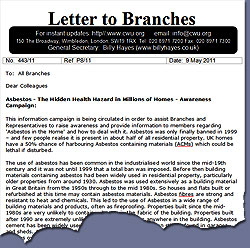 |
 |
|
CWU Issues Asbestos In The Home Campaign Warning One of the most important letters to branches issued by the CWU's Health And Safety Dept was sent to all CWU branches earlier this month. Asbestos remains a killer and the threat of it is in places you would not always consider. Writing in LTB443/11, Dave Joyce CWU National Health, Safety & Environment Officer deals with the issue of Asbestos in the home and alerts readers to the fact that it is still common and could still be found in up to 50% of UK homes. The LTB provides detail of Asbestos use and production and lists areas of the home that it may still be found in. Unionsafety recommends all readers of this website to download the LTB in full, and to pass the information contained within it to friends, family and colleagues. The LTB begins: "This information campaign is being circulated in order to assist Branches and Representatives to raise awareness and provide information to members regarding 'Asbestos in the Home' and how to deal with it. Asbestos was only finally banned in 1999 – and few people realise it is present in about half of all residential property. UK homes have a 50% chance of harbouring Asbestos containing materials (ACMs) which could be lethal if disturbed."
"The use of asbestos has been common in the industrialised world since the mid-19th century and it was not until 1999 that a total ban was imposed. Before then building materials containing asbestos had been widely used in residential property, particularly older properties from around 1930. Asbestos was used extensively as a building material in Great Britain from the 1950s through to the mid 1980s. So houses and flats built or refurbished at this time may contain asbestos materials. Asbestos fibres are strong and resistant to heat and chemicals. This led to the use of Asbestos in a wide range of building materials and products, often as fireproofing." Explaining the risk factor, the LTB continues: " Properties built since the mid-1980s are very unlikely to contain asbestos in the fabric of the building. Properties built after 1990 are extremely unlikely to contain asbestos anywhere in the building. Asbestos cement has been widely used as a cladding material and can still be found in garages and sheds. Asbestos was also used in some heat-resistant household and work products, such as oven gloves and ironing boards, Asbestos blankets etc. The use of asbestos in these products decreased greatly around the mid-1980s, and since 1999 any new use of asbestos in most products was banned. It is not always easy to tell whether a product contains asbestos as modern asbestos-free materials often look similar - remember it is usually older products that contain asbestos. Asbestos is a natural mineral made up of many small fibres. There are three main types: Blue Asbestos - Crocidolite, Brown Asbestos - Amosite and White Asbestos - Chrysotile." The LTB then gives some detail of advice to be found in Government advice leaflets: "While this may sound alarming, Asbestos is likely to be dangerous only if it is released into the air and you breathe it in. Then you could be at long-term risk of developing lung cancer, asbestosis or mesothelioma (a cancer that forms in the lining of the chest or abdomen). Experts say that there should be little or no risk if the asbestos is enclosed and left undisturbed but it must be regularly checked for signs of deterioration. "Directgov" advise that most people are exposed to low amounts of asbestos present in the atmosphere with no ill effects. Asbestos fibres and dust are potentially very dangerous if inhaled in higher concentrations over a period of time, when they can cause serious lung diseases including cancer. The symptoms of these diseases often do not appear for between 20 and 30 years after exposure to asbestos." The LTB also provides a PDF version of the above mentioned leaflet, which can also be downloaded via the E-Library Database, using the subject of 'Asbestos'. The letter to branches, LTB443/11 can be downloaded now using this link Source: CWU
|
